An early ripening variety of onions of a rich red shade - "Red Baron"
The variety of onion varieties is impressive. They differ from each other in the shape of the fruit, their taste, concentration of nutrients, color and other characteristics. Red Baron is one of the most popular red onions.
We will tell you about its features, planting, the nuances of growing and care in this article.
The content of the article
Description of the variety
Refined taste and unique properties made Red Baron famous throughout our country. Experts say that red onion varieties, unlike light ones, contain several times more antioxidants, they are more active in helping the body fight infections, aging and cancer.

Origin and development
Onions Red Baron - variety bred by Dutch breeders for cultivation in different climatic zones... It feels great both in warmer regions and in regions with cold weather conditions.
Chemical composition and useful properties
The chemical composition of a red vegetable is characterized by a high content of ascorbic acid and sugars, it contains many flavonoids that help the body to function properly and increase resistance to many diseases.
Useful properties of the Red Baron variety:
- Onion gruel relieves spasms and inflammation, swelling and pain, helps with muscle strain.
- This variety is often recommended by doctors to people with diabetes mellitus, with excessive salt deposition. Onion broth removes water well from the body.
- Regular consumption of red onions slows down or prevents cancer.
- Used as a dietary product reduces weight.
- Improves heart function, relieves stress, is useful for the prevention of atherosclerosis, lowers cholesterol levels.
- The grated onion effectively removes warts.
- Increases the acidity of the stomach, recommended for gastritis with low acidity.
Red Baron onions have the most useful upper juicy scales - they contain the most useful substances and trace elements.
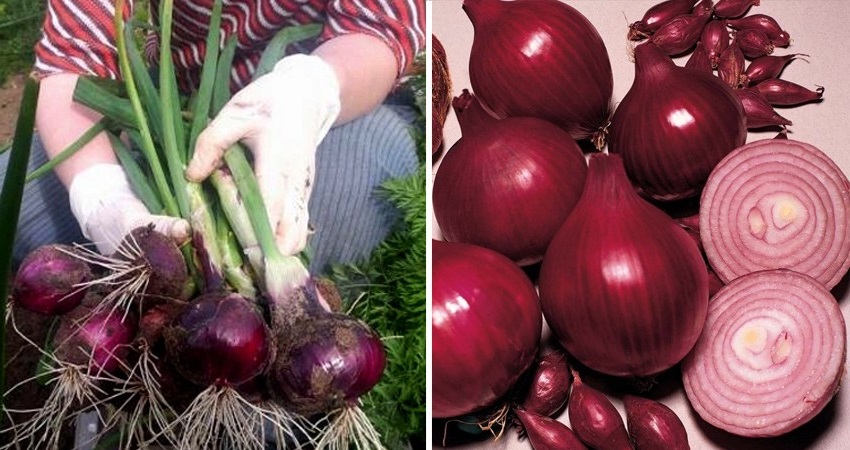
Ripening period
Red Baron considered a medium early variety... Harvesting begins around the second half of July, when 80-100 days have passed since germination.
Yield
Differs in high productivity. When sowing with seeds from 1 sq. m collect up to 3 kg of onions, and with 500 g of set, an average of 10-15 kg of large red heads comes out.
Disease resistance
Red Baron has increased resistance to fusarium, downy mildew and root rot with good soil drainage and regular loosening.
Characteristics of the bulb, description of the appearance, taste
If you look closely at the Red Baron bulbs, you will notice that they are more likely not red, but purple with a reddish tint. The inner scales are juicy, dark red.
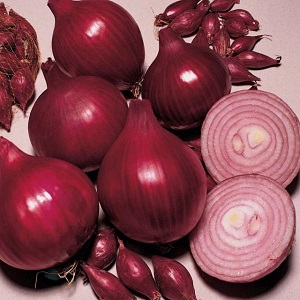 The characteristic features include the following:
The characteristic features include the following:
- the shape of the bulb is round, slightly flattened at both ends;
- leaves are dark green, with a slight waxy bloom;
- scales are difficult to separate, adhere tightly to the bulbs, which contributes to long-term storage;
- powerful root system, able to grow even in dry weather;
- the weight of one vegetable is on average 60-150 g, with proper care it reaches 200 g;
- the taste is mild, pleasant, without bitterness.
For which regions is best suited, climate requirements
The variety is almost universal in the region of growth... It is recommended to grow in the Central Black Earth and Central regions, it is suitable for the Volga-Vyatka District and the North Caucasus, it will be possible to grow an excellent harvest in the Ural climate and in the North-West of Russia.
Not tied to a special climate. Cold hardy but frost-resistant... In open ground it will withstand temperature drops up to + 2 ° C.
In hot weather, when the thermometer shows above + 30 ° C, it needs abundant watering.
The main advantages and disadvantages of the variety
The variety has more advantages than disadvantages.
Among the pluses:
 Early maturity. The yield will be high even in areas with cold climates, without loss of taste.
Early maturity. The yield will be high even in areas with cold climates, without loss of taste.- Intense color that does not disappear during long-term storage and does not color other products during cooking.
- High-quality ripening after harvest, attractive presentation.
- Long-term storage, subject to the necessary conditions, does not lose its qualities until June.
- Resistant to a range of diseases and pest attacks.
- Unpretentiousness to soil and climatic conditions.
- High transportability.
Minuses
Experienced vegetable growers the disadvantage of the variety is the cultivation of onions mainly by seeds, not planting sevka. It is quite problematic to buy a set of the Red Baron variety of good quality, without re-grading.
What is the difference from other varieties
Red onion variety Red Baron, except color, has a number of other characteristic distinguishing features:
- The bitter taste, characteristic of yellow and some white onions, is absent from the Red Baron.
- When cooking, it does not color the skin of the hands and vegetables in the salad red.
- Dessert varieties, to which the Red Baron belongs, do not take root well in the northern regions, and if they do yield, they lose their taste and color. Red Baron grows excellently in cold climates while retaining all its unique properties.
- Contains more, in comparison with other varieties, the amount of dry matter, antioxidants and ascorbic acid.
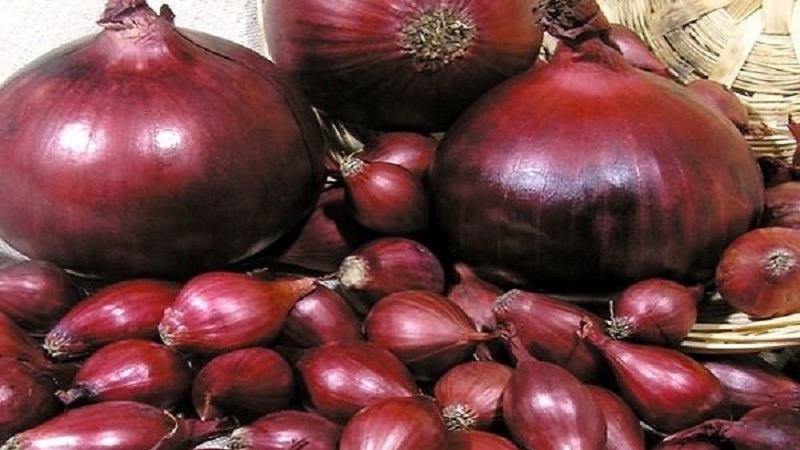
Features of planting and growing
Red Baron onion can be grown by seeds or using sevk... Let's consider both options.
Preparing for landing
Before sowing onion seeds are recommended to be dipped in a warm, weak solution of potassium permanganate for twenty minutes... Then put in a damp piece of gauze and put in a warm place for several days. Some gardeners use the Epin growth stimulator. They are sprayed with seeds just before sowing.
In small bulbs, the dry upper tail is cut off before planting., trying not to hurt the so-called growth point, then soak in warm water with potassium permanganate for 12 hours. If you didn't manage to do this, then dip it in a solution of copper sulfate for 8 minutes.
Ground requirements
The best harvest of Red Baron onions is obtained on clay-sandy, loose, light soil.... But loamy and acidic soil is best avoided.
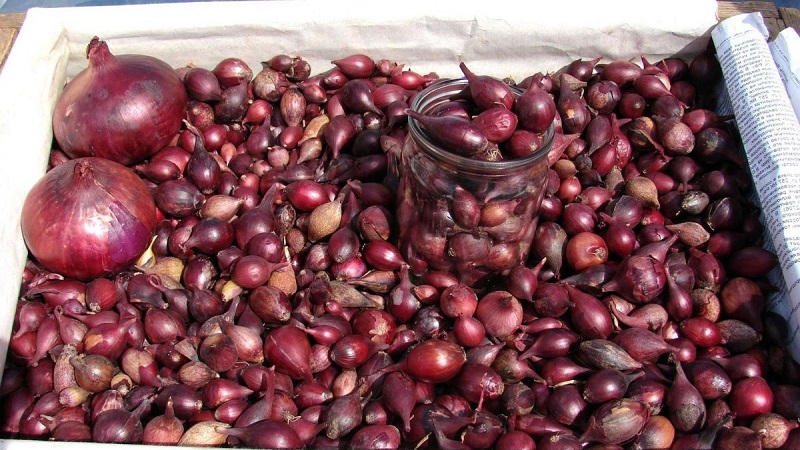
It is necessary to prepare the ground for planting onions in the fall.... To do this, choose a dry, well-lit place, dig it up, adding humus or compost at the rate of 3 kg of fertilizer per 1 sq. m. According to the rules of crop rotation, you need to plant onions in the same place where tomatoes, cucumbers or cabbage grow.
In the spring, the site is carefully weeded and, if necessary, dug again with a glass of wood ash per 1 sq. m. This should be done two weeks before planting seeds or sevka.
Timing, scheme and landing rules
Onion seeds are sown in the first half of April into grooves 3-4 cm deep, evenly distributing and pouring warm water. Then sprinkle with earth and lightly tamp. The distance between the rows is left about 5-7 cm.
Bulbs are planted in the ground at the end of April, the depth of the hole should be 6-7 cm, the row spacing is made wider - 14 cm, the distance of the heads from each other is on average 10 cm. It is necessary to lower the bulbs into the hole so that one fourth of the heads stick out from the ground.
Important! If you want your onions to have large, succulent feathers, fertilize the soil with potassium nitrate before planting. Add superphosphate for strong, large bulbs. Use one and the other at the rate of 1 tbsp. l. for 1 sq. m.
Growing features
Any vegetable crop requires compulsory care. Bow Red Baron is no exception, after landing he will need:
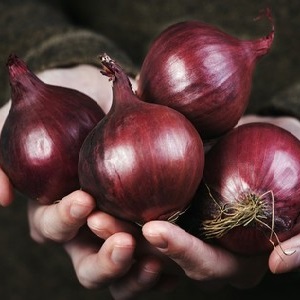 Obligatory regular weeding so that the still unformed root system of the planted seeds is not clogged with weeds.
Obligatory regular weeding so that the still unformed root system of the planted seeds is not clogged with weeds.- As soon as the seeds germinate and rise a couple of centimeters, the first thinning is carried out. This is done as needed, so that ultimately the shoots are 10 cm apart from each other. The planted seedlings do not need to be thinned out.
- Abundant watering is necessary for both seeds and small bulbs as they grow and develop.
The nuances of care
Red Baron is unpretentious in care, but there are three main points without which this onion will not give a rich harvest: Weeding, watering and loosening the soil is all you need to know about the nuances of caring for a red vegetable.
Watering mode
In abundant watering Red Baron most of all needs the first half of the growing season and in dry weather, and 15 days before harvesting, they stop watering it. Plants are watered at least once a week - 10-12 liters of water per 1 sq. m.
Loosening the soil and weeding
Another must-have item in the care of Red Baron onions is loosening the soil. Do it after watering or rain.so that a dense crust does not form on the soil, interfering with the respiration of the root system.
Timely weed control not only will enable the onion to grow and develop better, but will also protect it and other vegetable crops in the garden from a number of pests. Many parasites settle and rest after a "meal" on weeds.
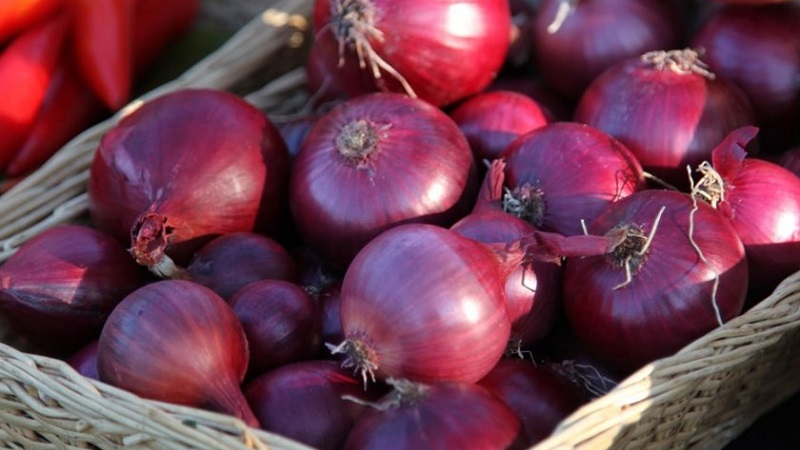
Top dressing
Growing Red Baron onions also includes timely feeding. This must be done at least three times per season.... The first top dressing is carried out two weeks after planting seeds or planting seedlings in the soil.
Water the mullein solution, diluting it with water in a ratio of 1:15 or superphosphate - 1 tbsp. l. on a bucket of water. The following dressings are done every two weeks - potassium sulfate is added: 1.5 tbsp. l. on a bucket of water.
Important! In order not to harm the root crop, fertilizing cannot be carried out later than mid-July.
Disease and pest control
Red Baron is resistant to a number of diseases, but is sometimes attacked bulb flies... The parasites lay eggs on the leaves of the onion, the hatched larvae feed on the juices of the plant, after 10 days the onion begins to stagnate and wither. As a result of the attack, the harvest shortfall will be about 30%.
Pest control measures are:
- observance of crop rotation - you can not plant onions in the last year's place of growth of carrots;
- weed control;
- wood ash after watering the onion in a thin layer is scattered between the beds and over the plants;
- chemical treatment with the preparations "Karate Zeon" and "BI-58N".
Harvesting and storage
As soon as the feathers turn yellow and fall down, they start harvesting... The bulbs are removed from the ground and dried.
How and when to collect
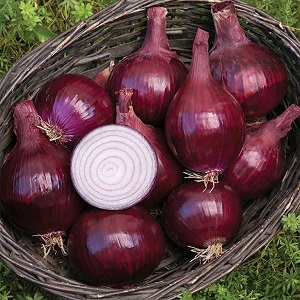 Harvest Luca Red Baron starts around mid-August... To keep it better, it is harvested in dry weather. Dig the onions with a pitchfork, not pull out the feathers, which will damage the integrity of the vegetable and make it unusable for storage.
Harvest Luca Red Baron starts around mid-August... To keep it better, it is harvested in dry weather. Dig the onions with a pitchfork, not pull out the feathers, which will damage the integrity of the vegetable and make it unusable for storage.
Then the bulbs are laid out under a canopy and dried for ten days... After the top husk of the vegetable dries, the roots and feathers are carefully cut off from it. Then it is dried again in a dry room for two weeks.
When the top husk is completely dry, the onion can be stored. It is placed in nets, bags or tied into comfortable "braids".
Storage features and keeping quality of the variety
Red onion variety Red Baron has excellent keeping quality and in the right conditions it will be able to maintain all its qualities until the beginning of summer.
It is important that all bulbs collected for storage are dry and healthy.... To verify this, sort. Place the largest, driest and hardest bulbs in one bag, the smallest in the next, and so on.
Attention! To prevent the onions from going into the arrow, the bulbs must be stored at temperatures between 0 and 5 ° C.
The storage room must be cool and dry, while bags of vegetables should not stand on the floor. Place a thick layer of cardboard or wood planks under them.
What can be the difficulties in growing
The main difficulty in growing Red Baron onions, according to experienced gardeners - to find a quality set in the store. Therefore, many grow it on their own.
Otherwise, this variety is unpretentious and easy to grow, beginners can also cope with it.

Tips from experienced gardeners
Take on a few tips experienced gardeners:
- When pulling up weeds while weeding, be careful not to pull the tiny onion seedlings with them.
- Young plants are watered carefully, not directing the stream directly to the vegetable, but trying to use a watering can with small holes.
- Don't overuse chemistry. It is advisable to spray plants with chemicals only when all other means no longer work.
- When planting sevka, do not save on land. If the bulbs are planted frequently, they will prevent each other from growing and the yield will be weak.
- When drying onions that have already been harvested, do not leave them in direct sunlight - this will ruin the bulbs. You will need a canopy.
Reviews of the Red Baron onion variety
Reviews of the Red Baron red onion variety are mostly positive.
Ilya, Naryan-Mar: “For a long time I tried to grow onions in the Arctic. Nothing worked. Last year I bought a set of Red Baron varieties. I planted it in early June. The bow did not go to the arrow, despite the summer frosts and for three months it pleased us with a dense, green feather and large bulbs. The Baron's keeping quality is satisfactory. The pungency is slightly lower than usual, but the taste is pleasant ".

Elena, St. Petersburg: “I have grown a small garden of Red Baron red onions. Excellent quality, good germination. The bulbs are strong, beautiful, incredibly tasty even raw in a salad. Lied all winter. This year I will definitely plant it again. Recommend!".
Conclusion
The red onion variety Red Baron is not only beautiful in appearance - it is tasty and healthy, it tolerates long-term storage well and has already become the pride of many gardeners. It is unpretentious, although it can become picky about watering in hot weather.
It is easy to grow it - it only takes a little effort and patience. It is important not to neglect preventive measures against pests, diseases and adhere to the recommendations and advice of experienced summer residents. Have a good summer!